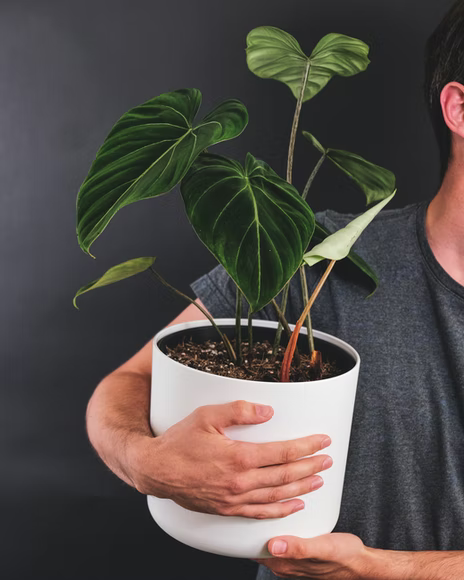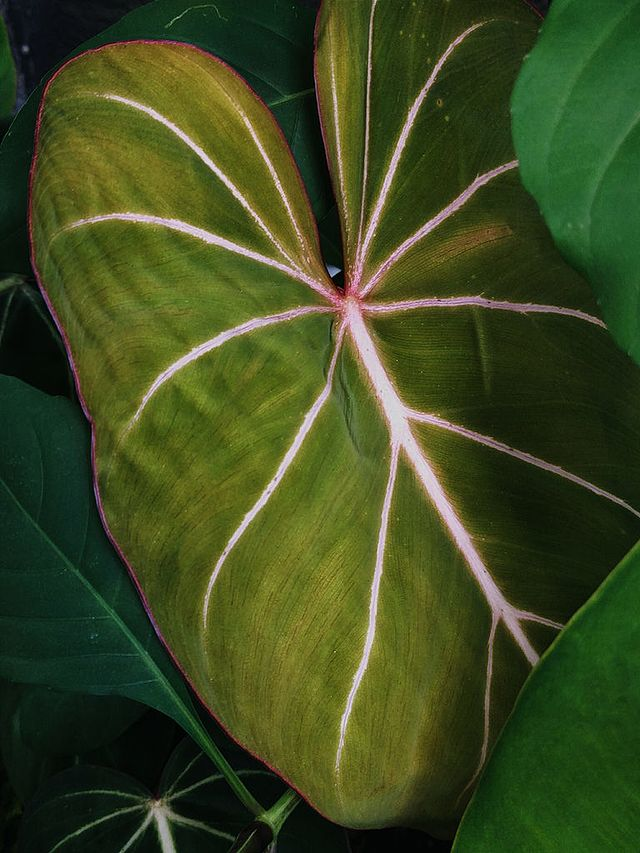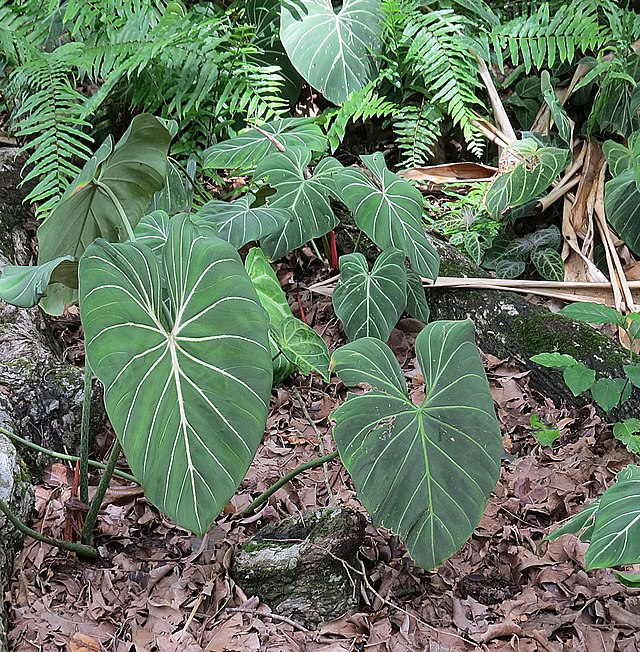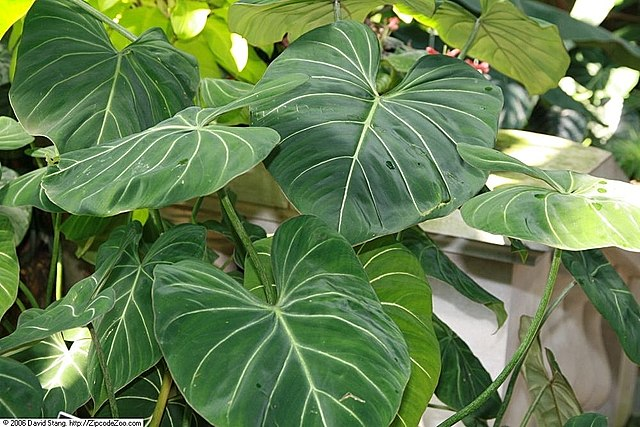Aroids have always been at the top of many plant collections. This gem holds no exceptions. The Philodendron gloriosum easily stands out due to its striking foliage and unique growing patterns. Unlike any other Philodendron species that are natural climbers, this one’s a creeper that will surely make into any plant lover’s heart.
Caring for this plant is a perfect leisure activity as it prefers to grow on its own at a slow and steady pace. Interested to know more? Keep reading!

Philodendron Gloriosum Profile
General Information
Philodendron gloriosum is a terrestrial plant from the Araceae family. It is a crawling plant philodendron with velvety green leaves that are heart-shaped with pale white veins that can grow up to 26 inches in length. When new sprouts of leaves grow, they have pinkish veins, and as they mature, they turn cream-colored to white.
Unlike other Philodendrons, which are climbers, gloriosum naturally creeps to the ground, wherein its stems grow horizontally along the surface. This plant is also known to be native to Colombia. However, it is also found in other parts of the world, such as Mexico, Central America, Peru, Ecuador, western parts of Brazil, and Venezuela.
This plant is called by many names. Its common names include Anthurium Gloriosum, Velvet Gloriosum, Creeper Plant, Creeping Philodendron, and Gloriosum Philodendron.
Etymology
The name “philodendron” comes from the Greek words “philo”, meaning “love” and “affection”, and “dendron,” meaning tree. So the Philodendron is loosely translated as “tree huggers” with these meanings. This is because they are often seen in the wild as tree climbers.
The Philodendron gloriosum is also commonly known as the Velvet Goddess due to its spectacular dark green, velvety leaves. And of course, it’s a vibrant houseplant that would always live up to its name: glorious, the direct translation of the Latin word “gloriosum”.
Flowering
Mature Philodendron gloriosum produces flowers in spring-summer, particularly between May and July. It has white flowers, consisting of a spathe and a spadix.
Season Of Interest And Purchasing
This plant grows actively from spring through summer. Therefore, you may want to purchase this plant during those times so you can supplement it with the right food and requirements.
Growth
This plant grows actively from spring through summer. Therefore, you may want to purchase this plant during those times so you can supplement it with the right food and requirements.
Philodendron Gloriosum Overview
| Scientific name | Philodendron gloriosum |
| Common name/s | Anthurium Gloriosum, Velvet Gloriosum, Creeper Plant, Creeping Philodendron, Crawling Philodendron, Gloriosum Philodendron |
| Family | Araceae |
| Growth Habit | Herbaceous, Epiphytic Vine |
| Height and Spread | up to 36 inches in height, and 24-36 inches in leaf length |
| Classification based on life cycle | Perennial |
| Origin and Distribution | Native to Colombia |
| Climate Zone | Generally mild climate |
| USDA Plant Hardiness Zone | USDA Zone 10-12 |
| Color | Green, velvety, heart-shaped leaves with pale white veins |
RELATED: Philodendron rugosum: The Care, Propagation, and Watering Guide You Need
Care Tips

Light Requirement
Bright, indirect light, either natural or artificial lighting, goes best with Philodendron gloriosum. However, a west or east-facing window may be ideal if you plan to put it indoors. South-facing windows also work, ensuring that the plants are placed further away from the window, so they do not get exposed to too much direct sunlight and cause their leaves to burn.
During winter seasons, your Philodendron might use a little help. You can use grow lights, especially if your plant is placed in darker home environments or office spaces where light is scarce and not readily available. Your plant will grow even better if it has enough bright indirect light, so make sure they get the right amount they need.
If your Philodendron plant starts to develop leggy and long leaves and considerable distances between the internodes of the leaves, it means your plant is not receiving the right amount of light. Again, direct sun is definitely a no-no or you will have crispy leaves!
Temperature Requirement
Indoor temperatures fluctuate throughout the seasons, so it is not safe to assume that your plant would be fine just because it is indoors. Ideally, tropical plants like Philodendron gloriosum love warm temperatures. They have an ideal temperature range from 50-90 degrees Fahrenheit. During the winter, make sure that you keep the plant indoors to avoid frost.
Water Requirement
Philodendron gloriosum prefers moist soil; dampy but not soggy. This might take some balancing and getting used to, but you’ll learn its preferences once you’ve watered your plant long enough. It is essential, though, to avoid overwatering as it can lead to root rotting, one of the main culprits of deaths of Philodendrons.
To water your plant, check first the soil. Stick your fingers into the topmost soil, and if they are completely dry, that means your plant needs watering. Please pay attention to its leaves also. When it starts to have drooping leaves or yellow leaves, it means your plant is being overwatered or underwatered.
To avoid this, rectify your watering schedule to your Gloriosum to about twice a week, depending on your indoor air quality, climate, and moisture level. You may use tap water for this plant.
Humidity Requirement
Humid conditions are essential for tropical plants as they come from rainforests with moderate to high moisture levels. This is because they are exposed to heavy rain in their natural habitat and thrive in a moisture level of 60% and above. So ideally, an environment with high humidity is best for Philodendron gloriosum.
This plant requires a misty environment. Ideally, these plants thrive in slightly higher humidities between 60-80%. They can also grow around 50%, but if it falls below 40%, you might need to get a room humidifier.
Soil Requirement
To maintain your Philodendron’s root health, a well-draining growing soil mix is essential. All-purpose houseplant potting mix or orchid mix also goes well with this plant. You may also add some perlite, orchid bark, and coconut coir to your potting mix to have better aeration and good drainage.
Fertilizer Requirement
Applying fertilizer to your Philodendron gloriosum once every four weeks is already sufficient for it to thrive and produce large, marvelous leaves. However, if you start to notice that your plant only has smaller leaves than expected or that its growth is slower than usual, then it is likely that your plant is not receiving proper nutrients.
You can slowly stop giving your plant fertilizer during the winter season, so your plant can take a rest and preserve vitality for the next year.
Space Requirement
Your plant will need planters or containers with efficient drainage holes, so the soil does not get soggy for an extended period of time. Waterlogged soil leads to root rot, one of the biggest problems of Philodendrons and other houseplants.
Also, note that Philodendron gloriosum is a creeping vine, so that it will need longer, rectangular containers. Unfortunately, unlike other Philodendrons, it does not thrive well from hanging or round pots.
RELATED: Philodendron verrucosum: The Number 1 Care, Propagation, and Watering Guide for This Velvety Plant
Growing And Planting Tips
Propagation
The preferred method for Philodendron gloriosum propagation is through stem cuttings. It is recommended that this is done during the spring and summer when this plant is actively growing. It is even relatively easier to propagate the Gloriosum due to the nature of its growth. Here are the specific steps you can do to propagate your plant:
- Only cut stems from the mother plant that is healthy and has a minimum of three leaves.
- Use shears or scissors that are clean and sterile.
- Pick a healthy stem that is 3-6 inches long. It should already have roots and leaves starting, too.
- Cut the stem to the point where it meets the main foliage
- Disinfect the cut side by sprinkling some cinnamon. Cinnamon works as a natural disinfectant and helps in healing wounds.
- Let your cutting remain in a dry and warm place with enough light for a number of days. This step is essential to prevent the stem from rotting before it has the chance to grow.
- Plant the root into a readied pot with appropriate growing soil.
- Moisten the soil regularly to grow roots and refer to the plant care tips above.
Pruning
If your gloriosums are growing too large for your space, it’s definitely okay to prune the plants’ leaves. Only trim it with clean scissors or shears at the stem’s base, then water it thoroughly to help in alleviating the plant’s stress. It may also be beneficial to remove dead, dying, or yellow leaves to keep your plant vibrant and healthy.
Potting And Repotting
When the plant reaches the edges of your pot, it will stop growing new roots, so it is important to ensure that your current plant is enough to grow gloriosum. Check the drainage holes for roots to know if your plant needs repotting. If roots are growing out of it, your plant may need a bigger pot.
You may also mix your regular potting soil with horticultural charcoal and organic matter to facilitate the growth of your plant. An orchid potting mix is also beneficial for gloriosum. Just make sure to have a well draining potting mix to avoid excess water to your plants.
Philodendron Gloriosum Care
| Light | Bright indirect light |
| Temperature | Intermediate to warm, 50-90 degrees Fahrenheit |
| Water | Once a week, increased in summer, decreased in winter |
| Soil | Airy, well-draining soil; not too loose |
| Fertilization | Regular household fertilizer, once a month |
| Space | Plenty of space to creep or climb |
| Propagation | Via stem cutting propagation |
| Blooming | Rarely blooms, enough sunlight and maturity needed |
| Pruning | Regular pruning |
| Potting | Regular potting mix, use of perlite and coco coir |
Related: Philodendron Florida Ghost: The Ultimate Care, Propagation, and Watering Guide
Problems And Troubleshooting
Yellowing And Drooping
Yellowing of the leaves usually means your plant is getting an excess amount of direct sunlight. Therefore, you may opt to move it to a different placement where it will not receive extra direct light or where it’s shaded with sheer curtains.
Meanwhile, drooping may be a result of excessive or insufficient amounts of water. To address this, adjust your watering schedule appropriately and always check your soil before giving water your gloriosum.
Diseases
Any plant can be susceptible to diseases if not properly taken care of. Particularly, plants of this family are affected by Septoria Leaf Spot and Alternaria Leaf Spot, which result in fungal growth. Usually, these are also due to over-watering the plants. Take action immediately when you see yellowing (Septoria) or brown spots (Alternaria).
You can treat your plants with a copper-based fungicide, and make sure to be attentive to the watering conditions for it not to happen again.
Pests
Houseplants are also susceptible to pest problems, and unfortunately, Philodendron is no exception.
If you observe the presence of pest infestation, the best thing to accomplish is to remove that plant and separate it from the other plants in your collection to avoid further infestation. These pests love to spread from plant to plant, so it is best to be proactive and isolate the infected plant.
The next thing to do, and frankly the easiest and simplest method, is to spray your plant with neem oil. Mix two teaspoons of neem oil and a teaspoon of soap in a spray bottle to make this spray. Add water to fill the bottle and shake properly. Spray the plant lightly, including its undersides, and repeat the treatment every 5-7 days.
Neem oil is a natural pesticide that makes it difficult for these bugs to respirate.
Philodendron Gloriosum Pests And Diseases
| Common Pests/Diseases | Symptoms | Treatment and Prevention |
Common diseases include crown rot, stem rot, root rot, leaf spot, fungal diseases, and Xanthomonas infection | Yellowish rimming around black or dark brown spots on leaves | Avoid overwatering. Keep soil dry. Avoid too high humidity.Proper ventilation is needed around the plant. Remove infected parts of fungal infections to avoid spreading |
| Common pests include mealybugs, spider mites, aphids, and scales | Visible insects on the surface | Spray plant with warm, soapy water. If infestation is present, use insecticide or neem oil. Use diatomaceous earth. |
Problems With People And Animals
Toxicity
All Philodendrons, including gloriosum, are toxic to people and pets. The calcium oxalate crystals found in the leaves and stems make philodendron gloriosum toxic. Make sure to place the plant out of reach from small children, cats, and dogs.
Philodendrons Plants Meaning And Symbolism

Philodendrons are said to symbolize love of nature, perfect for plant lovers and those who have a strong passion for eco-friendly living. They also symbolize personal growth, so they would make an ideal gift for someone who is going through major life events or making personal improvements.
Philodendron Gloriosum Symbolism And Meaning
| General Meaning | love of nature, passion for eco-friendly living |
| Symbolism | Personal growth |
Landscaping And Gardening Ideas

Companion Plants
Other tropical plants go well with Philodendrons, especially Monsteras and other Aroids. Some of the plants you may consider include bird of paradise, areca palms, fire spike, heliconia, variegated arboricola, croton, chenille plant, and pentas. Some of these plants will have additional colors and hues of warm oranges and reds, which will perfectly complement your cool dark greens.
Landscaping Ideas
Medium-sized Philodendrons go well as accents inside a humid room or a cozy deck or patio. A full plant can also be placed in the corner of the house or along the entryway. Outdoors, it can be a filler plant for a garden corner, in between palm trunks, or under tall trees. It can also be placed near pools to add even more tropical vibes as long as it won’t get splashed at.
| What to plant with | Other Aroids, Bird of Paradise, Areca Palms, Fire Spike, Heliconia, Variegated Arboricola, Croton, Chenille Plant, Pentas |
| What NOT to plant with | Basically nothing |
Conclusion

The Gloriosum is a difficult houseplant to find due to its high demand and rarity in the wild. So when you get your hands into these beauties, make sure to hold on tight and don’t let go! This plant will surely be a real treat, especially with its slow dramatic growth, exquisite markings, and majestic display. Just make sure to follow the tips above, and your plant will surely love you back.
Frequently Asked Questions
Is Philodendron gloriosum easy to care for?
The Philodendron gloriosum, although it could be hard to get a hand on, is easy to care for. The plant routine needed for this plant to grow healthy is pretty straightforward and easy to follow. Beginners can surely try to grow this plant in their homes.
Is Philodendron gloriosum fast growing?
The Gloriosum Philodendron is a relatively slow-growing plant. A leaf spike could take up to 1-2 months to fully open, depending on the environmental conditions.
How big does Philodendron gloriosum get?
The majestic foliage of this plant can grow up to 24 inches when grown indoors and 36 inches in the wild. The vine, however, grows up to 36 inches in length.
Is Gloriosum An Anthurium?
Definitely not. Gloriosums are members of the genus Philodendrons and not of Anthuriums. However, they are closely related since they come from the family Araceae. The same family of Alocasias and Monsteras.
Why is the Philodendron gloriosum expensive?
Philodendron gloriosum is expensive due to its rarity and high demand.
Do you like the Philodendron gloriosum? Comment below. Also, check out our other articles:
Philodendron Birkin: Its Most Informative Care, Propagation, and Watering Guide
Philodendron camposportoanum: The #1 Care, Watering, and Propagation Guide
Philodendron Erubescens: The Best Care, Propagation, and Watering Guide







